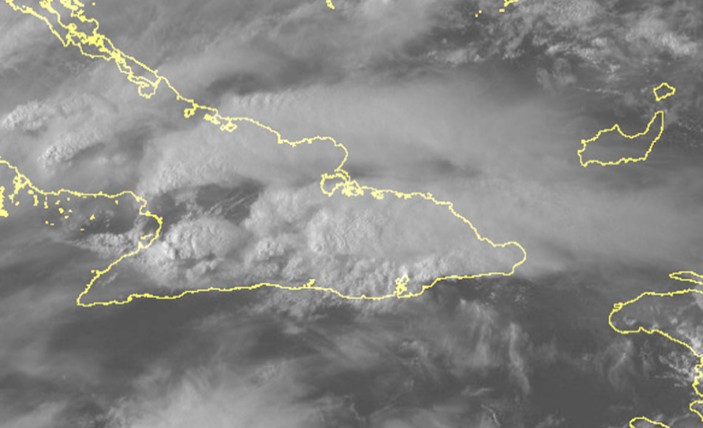Verification of the formation of supercell storms under the tropical and insular conditions of Cuba
Main Article Content
Abstract
Supercell storms represent the most organized form of deep convection that occurs in the atmosphere. In Cuba, their formation is considered unlikely due to the tropical and insular configuration that exists in the geographic area, although the possibility of these occurring in isolation under certain conditions is not ruled out. The objective of the research was to verify the formation of supercell storms under the tropical and island conditions of Cuba. Five case studies were selected considering severe events and patterns that a supercell storm can describe. The synoptic conditions of these days were analyzed, as well as images from the GOES 16 meteorological satellite and observations from the meteorological radar. In addition, data were extracted from the RAP numerical weather forecast model to analyze the two theories regarding shear and its influence on the formation of rotation within supercells. As results, the presence of supercell storms could not be verified under the tropical and island conditions of Cuba, however, the presence of storms with dimensions similar to the supercells formed in mid-latitudes was found.
Downloads
Article Details

This work is licensed under a Creative Commons Attribution-NonCommercial 4.0 International License.
Those authors who have publications with this journal accept the following terms of the License Attribution-NonCommercial 4.0 International (CC BY-NC 4.0):
You are free to:
- Share — copy and redistribute the material in any medium or format
- Adapt — remix, transform, and build upon the material
The licensor cannot revoke these freedoms as long as you follow the license terms.
Under the following terms:
- Attribution — You must give appropriate credit, provide a link to the license, and indicate if changes were made. You may do so in any reasonable manner, but not in any way that suggests the licensor endorses you or your use.
- NonCommercial — You may not use the material for commercial purposes.
- No additional restrictions — You may not apply legal terms or technological measures that legally restrict others from doing anything the license permits.
The journal is not responsible for the opinions and concepts expressed in the works, they are the sole responsibility of the authors. The Editor, with the assistance of the Editorial Committee, reserves the right to suggest or request advisable or necessary modifications. They are accepted to publish original scientific papers, research results of interest that have not been published or sent to another journal for the same purpose.
The mention of trademarks of equipment, instruments or specific materials is for identification purposes, and there is no promotional commitment in relation to them, neither by the authors nor by the publisher.
References
Chatterjee, P., and Prakash, P. (1989). A radar study of severe thunderstorms around Delhi, Northern India, during the Monsoon season.Atmospheric Research, 22 (1989) 373-384. Elsevier Science Publishers B. V., Amsterdam.
Carnesoltas, M. (2002). La brisa de mar y tierra. Conceptos fundamentales. Revista Cubana de Meteorología, 9(1). 39–60 pp: ISSN. 0864–151X.
Castro, A., Sánchez, J., Faile, R., y Madrid, J. (1989). Análisis de la estructura de las tormentas del Valle Medio del Ebro. Bol. San. Veg. Plagas, 15: 149-160, 1989. Laboratorio de Física de la Atmósfera. Universidad de León.
Davis-Jones, R. (1984). Streamwise Vorticity: The Origin of Updraft Rotation in Supercell Storms. National Severe Storms Laboratory,pp 2991.
Donaldson, R. J. (1965). Methods for identifying Severe Thunderstorm by radar: a guide and bibliography, bolletin AM5.
Doswell, C., and Burgess, D. (1993). Tornadoes and tornadic storms: A review of the conceptual models. The tornado: Its Structure, Dynamics, Prediction and Hazards, Geophys. Monogr., No 79, Amer. Geophys Union, 161-172.
Fujita, T. (1985). The downburst, microburst and macroburst. University of Chicago. SMRP Research Paper, (210).
Gamboa, F.; W. Vázquez, O. Rodríguez, C. Pérez, R. Aroche, R. Rubirosa, I. Medina y J.C. Antuña(1993). Complejo Radárico Automático para la Información de Lluvia Localizada (CRAILL). [inédito]. Informe científico al INSMET.
Gamboa, F. (2004). Selección de indicadores radáricos como productores de severidad. Tesis en Opción al Título Académico de Máster en Ciencias Meteorológicas. Instituto Superior de Ciencias Aplicadas. Ministerio de Ciencia Tecnología y Medio Ambiente, 55 pp.
Greene, D.R., and Clark, R.A. (1972). Vertycally Integrated Liquid Water – A New Analysis Toll. Mon wea, Rev., 100, 548 – 552.
Markowski, P. M. & Y. P. Richardson (2009). Tornadogenesis. Our current understanding, forecasting considerations, and questions to guide future research. Atmos. Res., 93, 3–10 pp.
Markowski, P., and Richardson, Y. (2010). Mesoescale Meteorology in Midlatitudes. Wiley-Blackwell. ISBN: 978-047-074-2136. 430 pp.
Quirantes, J. (2008). Nociones básicas sobre Supercélulas. INM, Agencia Estatal de Meteorología (AEMet).
Quirantes, J., Martín, R., y Mora, N. (2014). Características básicas de las supercélulas en España. Agencia Estatal de Meteorología (AEMET). NIPO: 281-14-008-X.
Rotunno, R., & Klemp, J. B. (1982). The influence of the shear–induced pressure gradient on thunderstorm motion. Mon. Weather Rev. 110, 136–151 pp.
Rotunno, R., & Klemp, J. B. (1985). On the rotation and propagation of simulated supercell thunderstorms. J. Atmos. Sci. 42, 271–292 pp. Sauvageot, H. (1982). Radarmeteorologie. Teledeteccion active de L' atmosphere. Ed, Eyrolles. Paris, France.
Stull, R. (2015). Practical Meteorology: An Algebra-based Survey of Atmospheric Science. ISBN-13: 978-0-88865-176-1.
Varela, R. (2017). Factores que intervienen en la formación de tornados en la región occidental de Cuba. Tesis en opción al título académico de Master en Ciencias Meteorológicas. La Habana, Cuba.
Weisman, M., & Rotunno, R. (2000). The use of vertical wind shear versus helicity in interpreting supercell dynamics. J. Atmos. Sci., 57, 1452–1472 pp.
Wicker, L. & Cantrell, L. (1996). The Role of Vertical Buoyancy Distributions in Miniature Supercells. Prepints, 18th Conference on Severe Local Storms, San Francisco, CA, American Meteorological Society, 225-229.
Zipser E. J., and Lutz, K. R. (1994). The vertical profile of indicator of storm intensity and lightning probability. Mon. Wea. Rev., 122, 1751-1759.

